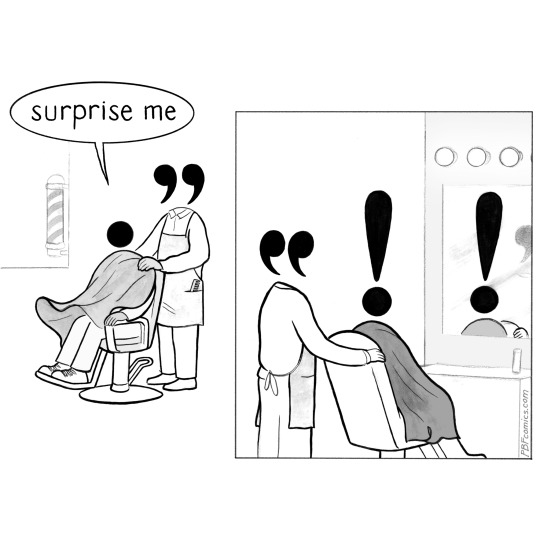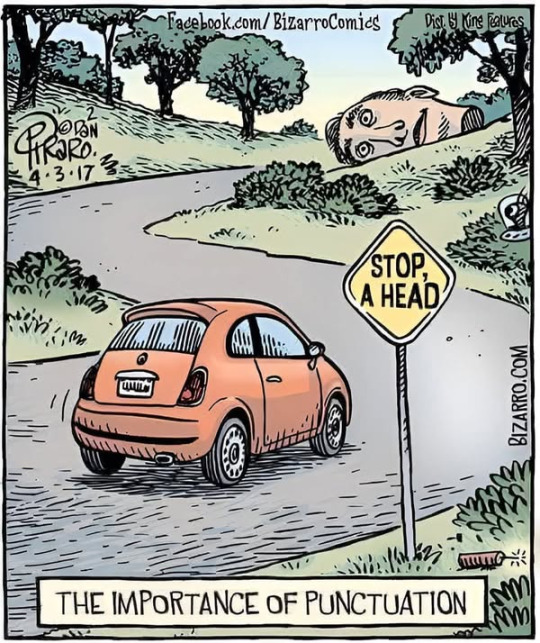#punctuation
Explore tagged Tumblr posts
Text
Okay, fine, you freaks. Correction: Archie finds Jughead's erotic experience funny, and Veronica is startled.
This is one of a number of pages at the time where Jughead tries to sneak into the drive-in with no payment. Somewhat surprising, maybe, as it is a duplicatable action -- give the kids ideas on circumventing the system, and hiding in the back trunk is dangerous, ain't it? This one may be a warning: don't steal a free movie, or you might get your groin pounded at the carwash. Oh, wait --
wet fret

No longer like them dashes.

Veronica is concerned where Archie finds Jughead's pain funny.
#Archie Comics#Archie Andrews#Jughead#Veronica Lodge#Carwash#Punctuation#Darkness#Dan Decarlo Jr#1975
25 notes
·
View notes
Text
The voices in my head.
👇
12K notes
·
View notes
Text

4K notes
·
View notes
Text
We ask your questions anonymously so you don’t have to! Submissions are open on the 1st and 15th of the month.
#polls#incognito polls#anonymous#tumblr polls#tumblr users#questions#polls about language#submitted july 5#punctuation#writing#grammar#syntax#language
837 notes
·
View notes
Text
So since any written work that uses em dashes is now flagged—usually incorrectly—as AI, it's time to fight back!
Many people avoid using em dashes because either a) they don't know how to use them, or b) the em dash is not on the keyboard, and people don't want to go searching through special-character menus.
Don't know how or when to use an em dash? Answer here.
Don't know when to use, or the difference between, an em dash, an en dash, or a hyphen? Answers here.
How to type an em dash: Shift-Option-minus on a Mac, or Control-Alt-minus on Windows.
Et voilà!
FUCK AI. USE THE EM DASH. FIGHT THE POWER.
661 notes
·
View notes
Text
!





















#pixels#favicons#carrd graphics#favicon#carrd stuff#tiny pixels#blog graphics#pixels art#decome#pixel dump#!#punctuation#exclamation mark#animated pixels#animated pixel art#sozai
478 notes
·
View notes
Text

Poetry Comics Month, Day 21: Punctuation
426 notes
·
View notes
Text
Proper Dialogue Punctuation Master List
Because I'm apparently illiterate when I write, here's the list I made to keep track of proper punctuation with dialogue — Enjoy!
Use double quotation marks to enclose spoken words. "I can't believe it's already Friday," Sarah exclaimed.
Place commas, periods, question marks, and exclamation points inside the closing quotation marks when they are part of the dialogue. "Have you seen my keys?" John asked. "I've looked everywhere!"
Use a comma to separate the dialogue tag from the spoken words:
Before the dialogue: Mary whispered, "Be quiet, they might hear us."
After the dialogue: "I think we're lost," Tom admitted, looking around nervously.
Start a new paragraph for each new speaker. > "Did you finish your homework?" Mom asked. > "Almost," replied Jimmy. "I just have math left." > "Well, hurry up. Dinner's almost ready," Mom said.
Use an em dash (—) to indicate interrupted speech.
For abrupt interruptions: "I was about to tell you that—" "Stop!" Jake shouted, cutting her off mid-sentence.
For self-interruption with action: "How on earth"—he shook his fists—"do I punctuate this?"
For interruption by another speaker: "How should we edit—" "Not we, Bob," Whitney said. "Fixing this punctuation is all on you."
For trailing-off speech, use ellipsis (...) inside the quotation marks. "I thought I saw something in the woods..." Jeremy whispered, looking around.
When dialogue is split by a tag, use a comma after the tag and lowercase the first word of the continued dialogue. "If we don't leave now," Dad warned, "we'll miss our flight."
For questions within dialogue, place the question mark inside the quotation marks. "Where did you put my glasses?" Grandpa inquired.
When the entire sentence containing dialogue is a question, place the question mark outside the quotation marks. Did she really say, "I don't care about the consequences"?
Capitalize the first word of dialogue, even when it follows a dialogue tag. The teacher announced, "Everyone, please take out your textbooks."
For dialogue interrupted by an action, use commas to set off the action. "Okay, here's the plan. I think we should go here, and," he rifled through the papers and maps, "if we don't find what we're looking for, we can move on."
When using exclamation points or question marks in dialogue, the first word of the following dialogue tag should be lowercase. "Watch out for that car!" he yelled. "How did you know?" she asked, her eyes wide with surprise.
When a character is quoting someone else in dialogue, you should use nested quotation marks. "I couldn't believe it when Sarah said, 'I'm moving to Paris next month.' It came as a complete surprise," John explained.
When a character is summarizing someone else's words in dialogue, you don't need to use quotation marks for the summarized speech. "I talked to Fred earlier," Mary said. "He told me he's been feeling overwhelmed lately and isn't sure how to handle his workload." "According to Sarah, the meeting went well, and everyone agreed on the new project timeline."
When punctuating thoughts, capitalize and punctuate thoughts as you would spoken dialogue. Use thought tags ("he thought," "she wondered") to orient the reader, similar to dialogue tags. She thought, When this week finally ends, my troubles will be over. Where did I put my keys? he wondered, searching his apartment. I wonder what he's thinking, Sarah mused as she watched John across the room.
Good Rules of Thumb:
If it's spoken (dialogue tags only, "he said," "she whispered") with no action, use a comma.
If it's an action while speaking, use a comma.
If it's an action completed before speaking, use a period.
If it's an exclamation mark/question mark before the dialogue tag, lowercase the pronouns following but capitalize all proper nouns (names) always.
If it's an exclamation mark/question mark after the dialogue tag, use a comma.
If it's the start of a standalone sentence, capitalize pronouns and proper nouns.
If you're confused about which to use (a comma and lowercase pronoun or period and capitalized pronoun), think "Are they doing this while speaking or after/before speaking?"
If your character is thinking, treat it like they're speaking.
If you're struggling to be consistent when writing, remember: it really doesn't matter. Perfection is an illusion, just write and use tools that make you happy. If you make a mistake, English is so complicated that most of the time, no one will notice. Now go write some great dialogue!
#writing advice#writing#writing help#fanfiction#fanfic#writeblr#writers on tumblr#writerscommunity#punctuation
335 notes
·
View notes
Text
Now that the winners of this poll and this poll have been determined, we must now find the ultimate winner...
137 notes
·
View notes
Text
We ask your questions anonymously so you don’t have to! Submissions are open on the 1st and 15th of the month.
#polls#incognito polls#anonymous#tumblr polls#tumblr users#questions#polls about language#submitted jan 1#language#punctuation#interrobang
383 notes
·
View notes
Text
Headcanon that instead of signing his threats Red Hood uses semicolons liberally (and correctly) because nobody up to their eyeballs in crime in his part of Gotham uses semicolons. ‘Don’t even try to run; I know all of your hideouts’ is a Certified Red Hood Threat. ‘I’m always watching; every minute every second’ is someone impersonating Red Hood.
#this results in a significant increase in the number of people who know how to use semicolons#because the criminals want to know if a message is from hood so they need to take it seriously#and the civilians need to know if an offer to help is genuine or a trick#the semicolon eventually becomes an unreliable way of telling real red hood messages from fake ones#because now everyone knows how to use a semicolon#meanwhile Jason rubs his hands together and gleefully mutters that it’s all going according to keikaku#and by keikaku he means his long term plan to increase literacy rates in crime alley#Red Hood#Jason Todd#DC#DCU#DC Red Hood#punctuation
926 notes
·
View notes
Text

#What to do if it Rains Question Marks#tips#tricks#life hacks#helpful hints#advice#question marks#punctuation
255 notes
·
View notes


